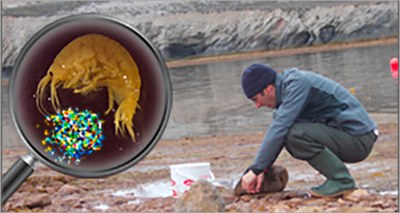Environment: Alarm in the Arctic Sea, crustaceans contaminated by microplastics
17/9/2020
 It’s microplastic alarm in the Arctic Sea, one of the places considered most pristine on the planet. A team comprising ENEA, CNR and Sapienza researchers has found fragments of microplastics in the amphipod Gammarus setosus, a small marine crustacean widespread in the Svalbard Islands, in the Arctic Ocean.
It’s microplastic alarm in the Arctic Sea, one of the places considered most pristine on the planet. A team comprising ENEA, CNR and Sapienza researchers has found fragments of microplastics in the amphipod Gammarus setosus, a small marine crustacean widespread in the Svalbard Islands, in the Arctic Ocean.
The situation is made more serious by the fact that this marine animal is the base of the feeding of several birds and fish that live in the area; in addition, most of the microplastics studied are made up of synthetic polymers of antifouling, waterproofing and anticorrosive paints and coatings used both in boats and in fishing equipment. The results of the study were published in the “Environmental Research” journal of the scientific publishing platform Science Direct (Elsevier publishing house).
The microplastics were identified through specific staining and infrared spectroscopy methods in samples collected in the coastal strip opposite Ny-Ålesund, beyond the 78th parallel north, as part of the activities of the Arctic Station "Dirigibile Italia", an Italian research base managed by the CNR, which takes its name from the dirigible protagonist of the expeditions led by the explorer General Umberto Nobile and his crew.
"The study conducted with the CNR and Sapienza shows that microplastics have also moved in the northernmost lands of the planet and can penetrate every level of the ecosystem, with long-term effects to organisms and the environment still largely unknown", Valentina Iannilli, researcher at the ENEA Biodiversity and Ecosystem Services Laboratory, pointed out.
"In fact, microplastics mistaken for food can reach the digestive system of animals, their tissues and then the edible parts of fish. Being a very abundant species (up to 3000 individuals per m2), the risk of moving all the way up to the human food chain is significant ”, she said.
Inside this crustacean of around 3 cm in size, an average of 72.5 particles of microplastic between 3 and 370 micrometers (millionths of a meter) were found, most of them smaller than a thirtieth of a millimeter (30 micrometers).
"The use of bioindicators such as this crustacean is crucial in monitoring microplastics, as it provides a much more realistic picture of contamination and above all indicates the potential for microplastics to transfer up the human food chain", Iannilli concluded .
For more information please contact:
Valentina Iannilli, ENEA – Biodiversity and Ecosystem Services Laboratory, valentina.iannilli@enea.it
https://www.sciencedirect.com/science/article/abs/pii/S0013935119306085
